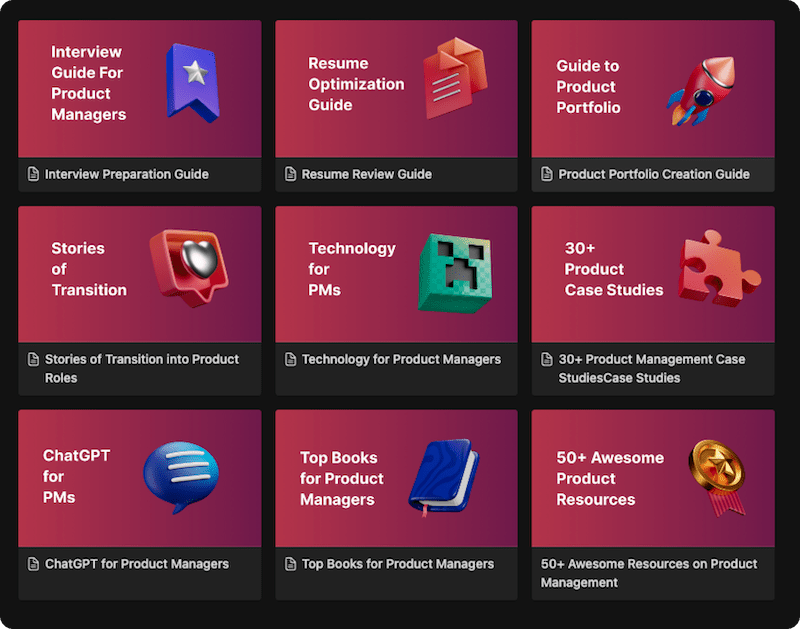Have you ever built a feature, convinced that users would love it, only to realize later that it wasn’t what they needed at all? As a product manager or an aspiring one, you’ve likely felt this frustration. The truth is, products fail not because teams can’t build them, but because they don’t build them for the right people.
That’s where User Personas come in. A user persona helps you understand who your users really are—their needs, motivations, frustrations, and goals. Instead of designing for “everyone,” personas allow you to design for someone specific, making your product more relevant, engaging, and successful.
This guide will take you from beginner to pro-level understanding of User Personas. You’ll learn what they are, how to create them, mistakes to avoid, and see real-world examples from top companies. By the end, you’ll feel confident building personas that actually inform smarter product decisions.
Definition & Origin: A Tool to Fight Self-Referential Design
The concept of the User Persona was pioneered by software developer and author Alan Cooper in the mid-1990s. In his influential 1999 book, The Inmates Are Running the Asylum, Cooper introduced personas as a method to combat a common problem: engineers and designers building products for themselves rather than for the actual users. He argued that to create user-friendly software, development teams needed a tool to help them adopt the user’s perspective.
Cooper’s personas were based on ethnographic research and were designed to be highly specific archetypes, not averages. The goal was to create a precise design target. This method provided a powerful way to achieve Stakeholder Alignment and ensure that every decision, from a minor User Interface (UI) tweak to the overall Product Strategy, was made with a specific user’s needs in mind.
Benefits & Use-Cases: The Strategic Value of a Persona
For a product manager, a well-researched persona is far more than a simple document; it’s a strategic asset.
- Fosters Empathy and a Shared Vision: A persona gives your entire Cross-functional Teams a shared understanding of the user. An engineer in a Sprint Planning meeting can ask, “Would our persona, Sarah, actually use this feature?”
- Guides Feature Prioritization: Personas help you focus your efforts. When faced with tough Trade-Off Questions, you can prioritize features that address your primary persona’s biggest pain points, using frameworks like RICE Scoring.
- Informs Design and Development: Personas are the foundation for creating effective User Stories (“As a [persona], I want to [action] so that [benefit]”). They also guide the creation of intuitive user flows and a better overall Customer Experience.
- Improves Stakeholder Communication: Instead of presenting dry data, you can tell a compelling story about your persona. This makes it easier to get buy-in for your Product Roadmap and justify your decisions.
- Refines Go-To-Market (GTM) Strategy: Personas help the marketing team understand where to find target users, what messaging will resonate with them, and what channels they use.
How It Works: A 5-Step Guide to Creating a User Persona
Creating a robust User Persona is a systematic process grounded in data.
Step 1: Conduct Comprehensive User Research
You cannot create a meaningful persona based on assumptions. The foundation must be data.
- Qualitative Data: Gather insights into why users behave the way they do. Methods include user interviews, contextual inquiries, and analyzing support tickets or feedback from a Voice of Customer (VOC) program.
- Quantitative Data: Understand what users are doing at scale. Use Product Analytics tools to track user behavior, analyze survey results, review demographic data, and use tools like Heat maps to see where users click.
Step 2: Analyze Data and Identify Patterns
Once you have your research, it’s time to find the patterns.
- Look for Clusters: Group users who exhibit similar behaviors, motivations, and pain points. For example, you might find a group of “power users” who use advanced features and another group of “newbies” who stick to the basics. This is a form of User segmentation.
- Synthesize Findings: For each distinct group, consolidate your notes. What are their common goals? What are their shared frustrations? What demographics do they share?
Step 3: Draft and Flesh Out the Persona
This is where the archetype comes to life. For each primary user group, create a persona.
- Name and Photo: Give the persona a realistic name and a stock photo. This makes them relatable and human.
- Demographics: Include key details like age, job title, location, and family status.
- Bio/Story: Write a short narrative about their life, work, and what a typical day looks like for them.
- Goals: What is this person trying to achieve, both personally and professionally, in relation to your product?
- Frustrations (Pain Points): What are their biggest struggles and challenges that your product could solve?
- Motivations: What drives them? Are they motivated by efficiency, creativity, social connection, or growth?
Step 4: Create the Persona Document
Organize all this information into a clear, visually appealing, one-page document. This should be an “at-a-glance” summary that is easy for anyone in the organization to read and understand. Include a quote that sums up the persona’s attitude to make them even more memorable.
Step 5: Socialize, Evangelize, and Utilize
A persona that sits in a forgotten folder is useless.
- Share Widely: Present your personas to the entire company. Post them on the walls of your office.
- Integrate into Your Workflow: Reference the personas in your PRD (Product Requirement Document), user stories, and design briefs.
- Make Them Part of the Conversation: During Backlog Grooming or design critiques, constantly ask, “How does this help our persona?”
Mistakes to Avoid: Common Persona Pitfalls
- Basing Personas on Assumptions (The “Proto-Persona” Trap): Creating a persona without research is a proto-persona. It’s a useful starting point for a team’s assumptions, but it must be validated with real data.
- Creating Too Many Personas: Most companies only need 3-5 primary personas. Too many will dilute your focus.
- Making Them Perfect: Personas should have flaws and frustrations. These pain points are where your product can provide the most value.
- Treating Them as Static Documents: Users evolve, and so should your personas. Revisit and update them annually or after significant market shifts.
Examples / Case Studies: Personas in Action
Here are two distinct examples for different product types.
B2C Persona Example: A Fintech App
- Name: “Side-Hustle Sam”
- Photo:
- Bio: Sam is a 28-year-old graphic designer living in a major city. He works a full-time job but earns extra income from freelance projects. He’s saving for a down payment on a house but struggles to track his irregular freelance income and separate it from his primary salary.
- Goals:
- Easily track income from multiple sources.
- Set and visualize savings goals.
- Get a clear picture of his monthly cash flow without complex spreadsheets.
- Frustrations:
- “My bank app lumps all my income together.”
- “Budgeting apps are too rigid and don’t account for my variable income.”
- “I have no idea how much I can safely spend each month.”
- Quote: “I need a simple way to see where my money is going so I can finally start saving seriously.”
B2B Persona Example: A BI Business Intelligence Tool
- Name: “Marketing Manager Megan”
- Photo:
- Bio: Megan is a 36-year-old Marketing Manager at a mid-sized e-commerce company. She is responsible for the marketing budget and campaign performance. She leads a team of 5 and needs to report on key metrics to her VP of Marketing weekly.
- Goals:
- Quickly build dashboards to track campaign ROI.
- Combine data from Google Analytics, Facebook Ads, and their CRM.
- Share easy-to-understand reports with stakeholders who aren’t data experts.
- Frustrations:
- “I spend hours every Monday manually pulling data into spreadsheets.”
- “Our current tools are too complex; I have to rely on an analyst for simple queries.”
- “I can’t get a single view of our customer journey across different platforms.”
- Quote: “I need to spend less time wrangling data and more time acting on insights.”
Related Concepts & Comparisons
User Persona vs. Market Segment
These two concepts are often confused, but they serve different purposes.
- Market Segments are about the “What.” They are broad, quantitative groupings of your customer base based on demographics, geography, or purchasing behavior. (e.g., “Males, 18-24, living in the Northeast, who have spent $50+”).
- User Personas are about the “Why.” They are specific, qualitative archetypes that focus on the motivations, goals, and behaviors of a user. (e.g., “Side-Hustle Sam,” who is motivated by financial security).
User Persona vs. Proto-Persona
- A Proto-Persona is created based on the internal team’s assumptions and existing knowledge before formal research is done. It’s a great tool for achieving initial alignment.
- A true User Persona is created after user research and is validated with real data. It replaces assumptions with facts.
Conclusion
In the complex world of product development, the User Persona is your anchor. It’s a deceptively simple tool that provides profound clarity, transforming abstract data into a human story that your entire team can rally behind. Moving beyond demographics to understand the deep-seated goals and frustrations of your users is the true foundation of a successful Product-Led Culture. A well-crafted persona ensures you’re not just building a product right, but that you’re building the right product for a real person.
As a product manager, championing the creation and use of personas is one of the most impactful things you can do. It is your single best tool for building empathy, driving alignment, and making confident, user-centric decisions in the face of ambiguity. Don’t let your user be a vague, shifting target. Give them a name, a face, and a story. Let that story be the guide that leads you to build products that don’t just solve problems, but that truly resonate and earn a loyal following.
FAQ’s
Most organizations find that 3 to 5 personas are sufficient to represent the majority of their user base without losing focus. You should always have one primary persona that is your main design target.
Yes, a “negative” or “exclusionary” persona can be very useful. This is an archetype of the user you are not building for. It helps prevent Feature Bloat and keeps the team focused on the target audience.
A buyer persona focuses on the purchasing process (their budget, their buying motivations, their role in the decision). A user persona focuses on how someone will use the product after purchase (their goals, tasks, and pain points with the product itself). In some cases, they can be the same person, but often they are different.
No, a persona should be a composite archetype synthesized from the data of many real users. Basing it on a single person is risky, as that individual’s needs may not be representative of the larger user group.
Learn better with active recall quiz
How well do you know What is a User Persona? Let’s find out with this quick quiz! (just 10 questions)


